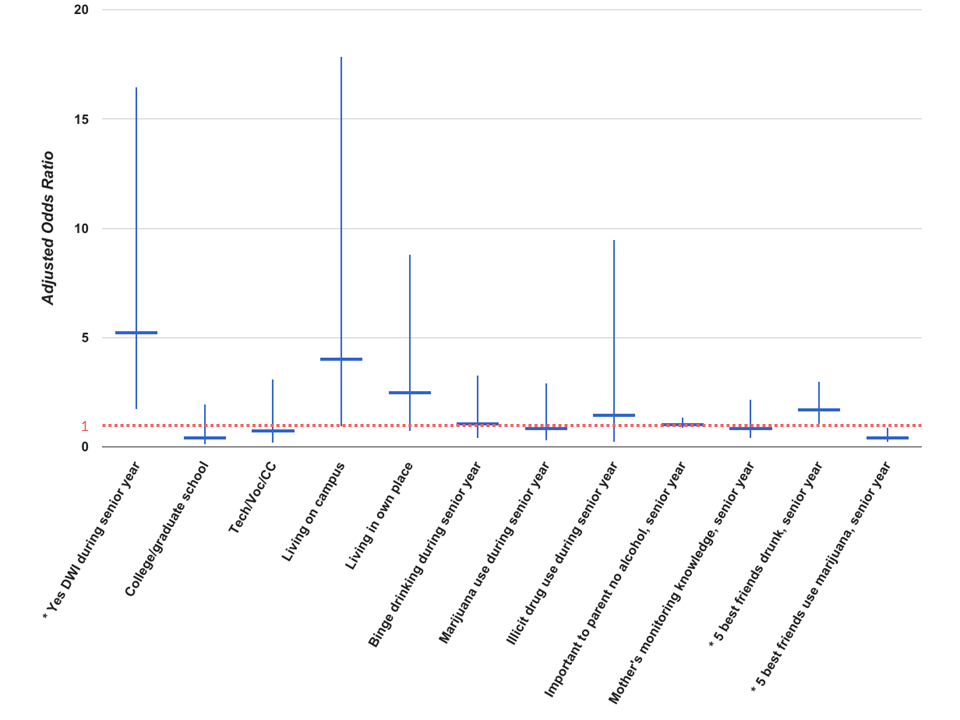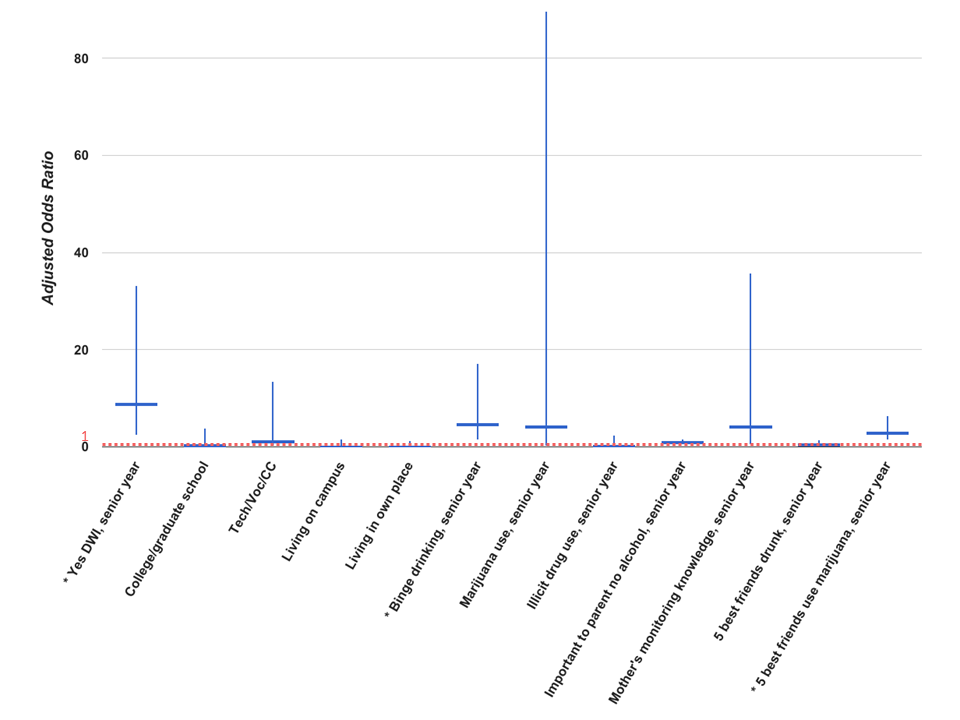The transition for young adults after high school is marked by new found freedoms and responsibilities. For some, that freedom leads to increased substance use and possibly getting behind the wheel of a motor vehicle while impaired. Factors that put people at increased risk for Driving While Intoxicated (DWI) include alcohol availability, poly-substance use, and trauma, emotional, and mental health problems. Young adults who DWI are more likely than older adults who DWI to get into an accident, likely due to a combination of inexperience with driving, aggressive driving, and the effects of alcohol on the body. This week’s DRAM reviews a study by Kaigang Li and his colleagues that explored predictors of alcohol and drug impaired driving one year after graduating from high school.
What was the research question?
What personal and environmental factors in 12th grade predict future DWI?
What did the researchers do?
Li and his colleagues analyzed data from Waves 3 (12th grade) and 4 (1 year after HS) of the NEXT Generation Health Study. During 12th grade, 1,208 students responded to questions about DWI, parental behavior to prevent youth substance use, peer alcohol and marijuana use, drinking and binge drinking, and drug use. One year after high school, researchers asked about substance-specific DWI (alcohol only, marijuana only, combined alcohol and marijuana, or other illicit drug related only), and potential confounders. They used multinomial logistic regression to compare young adults who did not drive while intoxicated to those who did to see if any of the factors measured during 12th grade uniquely predicted DWI 1 year after high school.
What did they find?
Li and his colleagues found 14.3% of young adults reported past month DWI in 12th grade and 15.2% did so 1 year after high school. As Figures 1a and 1b show, young adults who reported any DWI during 12th grade were more likely than others to report alcohol-specific and combined alcohol/marijuana DWI 1 year after high school. Those who reported binge drinking during 12th grade were more likely to report alcohol/marijuana combined DWI but not alcohol-specific DWI one year later. Young adults who perceived that more of their friends got drunk during 12th grade were more likely to report alcohol-specific DWI 1 year after high school. Young adults who perceived that more friends used marijuana during 12th grade were less likely to report alcohol-specific DWI, but more likely to report alcohol/marijuana combined DWI 1 year after high school. Illicit drug use, school status, residence, and parental behavior to prevent youth substance use during 12th grade had no significant impact on later DWI behavior.
Why do these findings matter?
DWI is a dangerous and illegal behavior that often leads to death or the destruction of property. This study lends support to prevention efforts for substance use and DWI that focus on perceptions of small group social norms and the social networks of high school students who drink or use drugs. Identifying kids who have these risks will provide an opportunity to address underlying issues before they lead to substance use disorders or criminal behavior such as DWI, and ultimately, save lives. Though parental behavior was unrelated to future DWI, parents might have an indirect influence on future DWI by encouraging their kids to form healthy (i.e., non-substance using) social networks.
Every study has limitations. What about this one?
Although the study sample was large, only between 2.4% and 5% of students reported engaging in each of the four substance-specific DWI. This probably helps explain why the researchers dichotomized many of the measures, including frequency of DWI and substance use into yes or no measures. It might be interesting to increase the sample size so the relationship between substance use and DWI can be analyzed as continuous variables. Finally, the 1 year follow-up period after high school seems short considering the prevalence of substance use increases with age.
Figure 1a. Adjusted Odds Ratios for Post-High School Alcohol-specific DWI, adapted from Li et. al., (2016). Click image to enlarge.
Figure 1b. Adjusted Odds Ratios for Alcohol and marijuana combined DWI, adapted from Li et. al., (2016). Note. * indicates findings with statistical significance. The horizontal bar is the adjusted odds ratio and the vertical line is the confidence interval. Click image to enlarge.
For more information:
If you are concerned about yours or a loved one’s substance use, visit our resource page for brief screens to assess substance use and self-help tools.
For more information about DWI visit the CDC’s impaired driving fact sheet.
— John H. Kleschinsky
What do you think? Please use the comment link below to provide feedback on this article.






